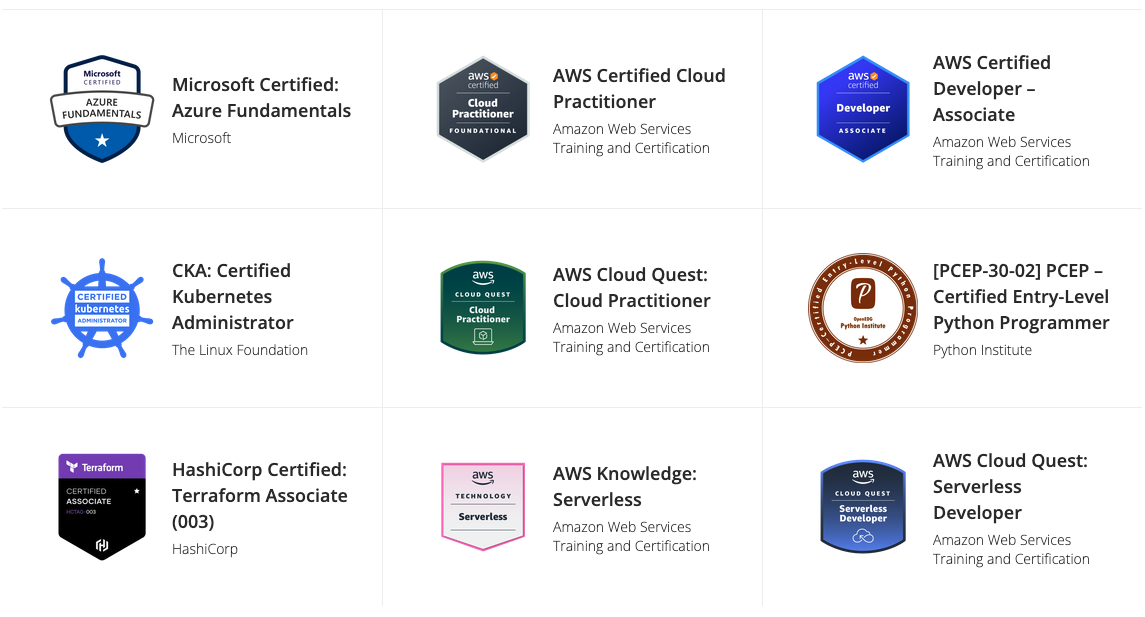Intro

My journey in the realm of Information Technology began as a Windows system administrator,
responsible for managing Windows servers and overseeing network infrastructure. As I gained
experience,
I expanded my horizons by diving into the world of Linux and network architecture,
becoming proficient in these areas. With a solid foundation in both Windows and Linux,
I transitioned to roles that involved designing and optimizing network infrastructures,
ensuring connectivity, security, and efficient data flow.
Eager to broaden my expertise, I ventured into DevOps,
mastering tools like Kubernetes, AWS, Docker, and Ansible.
These became pivotal in my career, enabling me to orchestrate
containerized applications, harness the power of the cloud for
scalability, and automate various IT operations. I didn't stop at learning;
I obtained certifications in these DevOps tools, solidifying
my knowledge and expertise.
With these certifications in hand,
I stood at the forefront of IT innovation,
ready to bridge the gap between development and operations,
and contribute to efficient software delivery.
My journey, marked by continuous learning and skill acquisition,
allowed me to evolve from a Windows sysadmin to a certified DevOps professional,
shaping the future of IT architecture and making a significant impact
in the organizations I served.
Please check my engineering achievments
Work

My enginnering achievments in Macropay:
- By implementing Vertical Pod Autoscaling (VPA), I reduced the cost of three Kubernetes clusters by
34%, optimizing resource utilization and aligning with a broader goal of pipeline efficiency.
This effort contributed to an overall 32% increase in delivery speed for CI/CD pipelines, achieved
through streamlined resource management and the adoption of DevSecOps tools to enhance security and
automation within the pipeline.
- To further reduce costs, I consolidated Application Load Balancers (ALBs) by grouping them by
namespace, achieving a 25% cost reduction.
- Additionally, I integrated ArgoCD into the pipelines, enabling version control for manifests and
enhanced control over manual changes in clusters, ensuring compliance and operational consistency.
- Finally, to maximize cost savings during non-peak hours, I implemented a strategy to scale
Deployment replicas down to 0 for DEV and QA clusters during the night, resulting in an impressive
38% cost savings. These interconnected initiatives collectively improved efficiency, reduced
expenses, and fortified the pipeline’s operational capabilities.
My enginnering achievments in SPB SBEI "College of
Olympic Reserve №1":
- I implemented a comprehensive network and server modification initiative that yielded remarkable
results.
As a part of this upgrade, Cisco managed switches were strategically deployed across every
subsection of our
infrastructure. This strategic shift replaced the previous configuration where multiple unmanaged
switches were
set up sequentially.
This strategic implementation brought about a multitude of benefits. Notably, it significantly
bolstered network
reliability and enhanced the speed of response across our systems. Moreover, it had a direct
positive impact on the
incident detection time, reducing it to an impressive degree. By transitioning to managed switches,
we've
streamlined network management, increased our capacity for proactive monitoring, and fortified our
infrastructure
against potential disruptions. This transformative change has not only optimized performance but
also fortified our
overall operational stability.
- We executed an Active Directory implementation program to enhance security, control, and
management of
College resources, achieving centralized user authentication and access control. This initiative
bolsters data
protection and minimizes unauthorized access while streamlining resource allocation based on roles.
The result is a more secure, efficient, and well-organized system for managing College assets.
Mt engineering achievments in "Plant of dosing equipment "Areopag":
- Exchange migration from 2007 to 2013. Exchange Server 2013 introduced a modern architecture,
enhancing
performance and scalability over Exchange 2007. Database Availability Groups (DAGs) provided
automatic
failover and high availability for mailbox databases. Improved user experience came through a
revamped Outlook Web App (OWA) interface with features like conversation view and responsive design
- Installing and configuring Mikrotik hardware. Switching to Mikrotik routers accomplished
redundancy and
increased bandwidth with two ISP on the facility site. Changed from Kerio host on the main office
improved peed and bandwidth of the main office and the increased ability for faster cloud backups
- Installation and configuration of the Zabbix server. Integration of Zabbix monitoring network
hardware and
servers allowed for faster prediction and the reaction for implementation of necessary actions
before the service become unavailable
- Integration of the Veeam Backup server made it possible for better scheduling full backups,
increments backups of
VM, filesharers, folders, and hosts to backup storages and cloud. In case of failure of the Virtual
Machine, become possible to restore it in a matter of minutes
- Integration of a seamless network of UniFi points as a backup network for tablets installed for
numerically
controlled machines.
Certificates

Google
Cloud Digital Leader
AWS Certified Developer
– Associate
AWS Certified Cloud
Practitioner
AWS Knowledge:
Serverless
Microsoft Certified:
Azure Fundamentalss
CKA: Certified
Kubernetes Administrator
Certified Entry-Level
Python Programmer
HashiCorp Certified:
Terraform Associate (003)r
LE-1: Linux
Essentials
Contact


